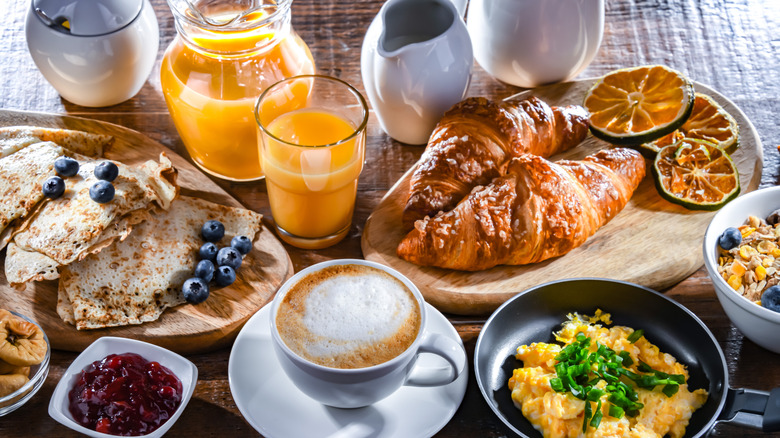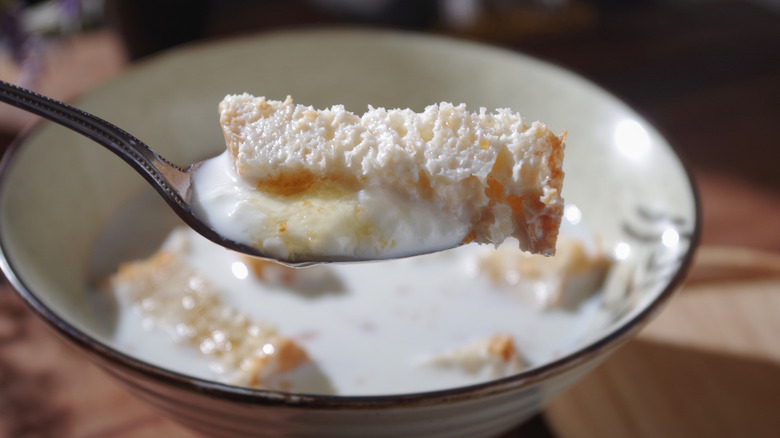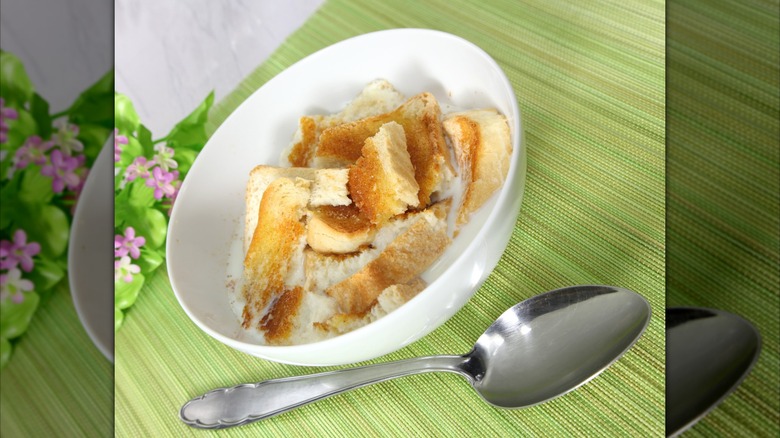The Once-Popular Breakfast That's Rarely Eaten Anymore
Whether it's slathered with butter or drenched in jam or marmalade (which actually aren't the same thing), toast is something most people have eaten for breakfast. Even the rich and famous like a good, crunchy slice in the morning — even Ina Garten likes hers with a bougie ingredient, real French butter. But have you ever thought of ripping up your toast and sending it on a swim in a bowlful of milk? It's not crazy — it's actually a forgotten breakfast food that no one eats anymore.
Once upon a time — in the 19th and 20th centuries, to be specific — a dish called milk toast was commonly eaten. In addition to being a breakfast staple, it also sometimes made an appearance at dinner — particularly when there was stale bread or rolls that needed to be used up. Milk toast was also often prescribed as something mild and bland to eat for those with upset stomachs or other ailments.
The recipe is simple. As the name implies, the foundational ingredients are bread and milk. Heat the milk gently on the stove (or in the microwave), and, depending on which recipe you follow, either pour it over the toast or add the toast last. Once you've toasted the bread, you generally break it up into pieces or cut it into cubes, though a whole, unbroken slice of toast is also acceptable.
What happened to milk toast?
It's unclear exactly why milk toast lost its popularity as a commonly consumed dish. Since it was considered rather a poor man's meal, utilizing simple ingredients that poor families had plentifully at hand, improvements in the common household income could have played a part. If you could afford more upscale options, cheaper meals were likelier to fall by the wayside. Also, with a changing society, fewer families were living on farms and, therefore, no longer had an overabundance of fresh milk and homemade bread at hand that needed to be creatively used up.
In tandem with these factors, some theorize milk toast was unseated by cold cereals becoming more widely available (sweet renditions of milk toast are basically a warm version of Cinnamon Toast Crunch, after all). Cold cereals were simply a more convenient option for families dwelling in cities and living on market-purchased foods rather than farm-fresh goods. The increasing variety of sugary cereals was also likely more enticing to young family members than the simple bread-and-milk dish.
Since milk toast also had a reputation as a remedy for illness — or being a sickroom food — that association could have further helped spell its demise. As the common person was eating more things for pleasure rather than mere necessity, a dish linked to illness and recuperation would hold less appeal.
Variations on milk toast
Milk toast can be either savory or sweet, though sweet seems to be the most common approach in surviving recipes that are still in circulation. The sweet version can be arrived at in a variety of ways. Some recipes call for using white sugar (either added directly to the milk or sprinkled on the toast) while others use brown sugar, and still others utilize sweeteners like maple syrup. A sprinkling of spices, like cinnamon or nutmeg, is sometimes added, as is vanilla extract.
On the savory side, unsweetened versions include seasoning the mixture with salt, with some recipes also adding black pepper, and others using red pepper. Some preparations use butter, while others don't. When butter is included, it is either spread on the toast — the way toast is traditionally made — or, in some instances, added at the end and mixed in with the milk.
The type of bread used in making milk toast also varies widely. Some say any kind of bread will do, though stale breads can stand up to the milk better than fresh. Others maintain that using a variety that is sturdy to begin with, like sourdough, works best. Milk bread — a recipe of Japanese origin — shows up in some recipes, while others advise using brioche or challah. Still, others don't call for regular bread at all but incorporate biscuits into the dish. Whichever approach you take — or maybe you'll invent a variation of your own — adding hot milk to toast is the foundational element to build upon.
Some versions of the dish go further, adding a fried, poached, or boiled egg to the finished concoction. Still others include fresh or home-bottled fruit as an accompaniment.



